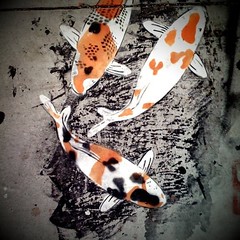DIY Stencils
Image Courtesy Workshop.com
If you’ve lived in San Francisco for any length of time you probably know Jeremy Novy’s Koi fish stencils – in fact, it’d be hard not to notice them since there are over 2,000 koi stencils spread throughout the city. I have a particular fondness for the school of koi underneath the Defenestration Building on 6th Street and Howard;trust me when I say that they were the only pretty thing I ever saw the entire time I worked on 6th Street.
Recently, my crafty compatriot Chuck sent me photos of his most recent project: stencils of Chewbacca and ODB (which he used to make iron-on patches that he stitched down with red thread) and it got me thinking that much like stamps, stencils are useful for just about any-damn-thing from tshirts, bags, and wrapping paper to drapes, floors, mirrors, furniture, plates – and of course sidewalks (speaking of which…Novy himself teaches the Art for Outlaws: Street-style Stenciling class at Workshop). Stenciling goes back to the prehistoric period – this is old-school DIY and there’s a reason it’s still being used today: it’s super versatile and hella easy.
The process is pretty straightforward, regardless of the materials you’re working with – find image, trace onto plastic sheet, freezer paper, adhesive foil, etc, then cut out, adhere to surface, paint, dry, rock out. There are a few tricks you should probably know, first: this works best with large, symmetrical blocks of space and patterns as opposed to fine, detailed lines.
T-shirts (and other fabric like curtains or bags ) bunch and move so you’re gonna have to hold the stencil in place, either by adhering the stencil with tape or by making your stencil from freezer paper and gently pressing onto the shirt with an iron. Also, instead of paint, consider experimenting with bleach. Either way, you’ll definitely want to remember to slip a paper bag or something absorbent underneath the fabric to sop up the paint that seeps through.
Mirrors actually require a little more care, and contact paper instead of plastic or freezer paper. First, apply the contact paper smoothly then draw your pattern and lightly trace with an Xacto blade. Peel carefully and you’ve got your stencil right there stuck to the glass, just paint with latex or acrylic paint.
If you’re down with Photoshop, then you’ll have the option to make a stencil from a photograph which makes for some avant garde stencil art (and stellar gifts). UPDATE: Sara Lopez (who’s site you go to if you click the last link) says she didn’t even use photoshop. She just used MS Word. Word!



